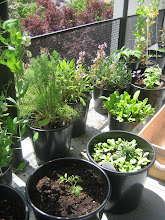Saturday, September 17, 2011
Lemon Dilemma
Because I am a single gal, I usually don't use a whole lemon before it gets all wizened into a rock. I solved that problem by keeping lemon wedges in the freezer, but one consequence of freezing lemons is that when you thaw them out, the lemon oil in the rind tends to make your food bitter.
The lemon zest is where most of the oil in the rind is- which is a good thing if you want a pinch of it minced up to flavor something with. Not so good when you microwave a frozen lemon and you can't control how much peel flavor goes into your lemon juice. I decided that was something I could live with if it meant that I could have fresh tasting lemon juice without wasting most of a lemon, until I read somewhere that you can preserve lemon zest in salt or sugar. Hmmmm. If I zipped all the outsides of my lemons off before freezing them, I would have solved the bitter-lemon problem, as well as saved the good parts of the rind for something else, right? So the last time I bought half a dozen lemons, I saved the zest in a pint jar of sugar.
Well, now I have 2 cups of lemon sugar to use up. No big deal, but who on earth actually uses as much lemon zest as that? Next time, I think I'll just freeze some of it separately and make myself throw the rest away, like a sensible person. Meanwhile, here are some lemon bars.
2 cups all-purpose flour
1/2 cup powdered sugar
3/4 cup butter -I use salted. If you don't, then add 1/4 tsp salt to the crust.
5 eggs
3/4 cup lemon juice
1 1/2 cups sugar- I used 1 cup plain, 1/2 cup lemon sugar.
1 tsp baking powder
1/4 cup flour
1/4 tsp salt
Pre-heat the oven to 350. Line the bottom of a 9x13 pan with waxed or parchment paper.
Cut the first 3 ingredients together with a pastry tool. Unlike normal pastry, you don't want to leave butter lumps in the dough. It's done when it looks almost moist, but still crumbles easily. Dump the crumbs into the pan, distribute them evenly over the bottom, and then press them down firmly into a nice solid crust. Prick the crust all over with a fork to prevent it from bubbling up in the oven, and bake it for about 13 minutes. It should be barely browned around the edges by that time. Remove the crust from the oven, and turn the heat up to 375.
Beat all the rest of the ingredients together until completely combined. Pour over the crust, and bake for 15-20 minutes, or until the filling has set. When they are cool, sprinkle the tops with powdered sugar and cut them up.
Notes:
1. While the bars are still hot, take a very sharp, thin, knife and run it around the edge of the pan to separate the bars from the baking dish. On a related note,
2. Don't be tempted to use a non-stick pan. Even if the bars don't stick to the sides of the pan, you still have to cut them up, which will just gouge holes in your teflon. I am against teflon anyway.
3. You really do have to wait until they are cool to put the powdered sugar on top. If they are still warm, the steam coming off the bars will just make the sugar dissolve. I think Harriet did that once. They still tasted fine, but they didn't look the same and the tops were pretty sticky.
4. The amount of time the filling will take to set up depends on how cold your ingredients are. I use eggs right out of the fridge, so they take on the long side to cook.
5. Oil the knife you use to cut them with. This part isn't mandatory, but it makes them come out prettier, because they stick to the blade less.
This is a pretty good formula. It makes a good sized batch, with a nice proportion of lemon stuff to crust. I looked up a bunch of recipes before I made these, and I think I incorporated the main features that attracted me to each. I used less total sugar than most recipes called for, and more lemon juice. I added an egg to compensate for the extra juice, which had the added benefit of increasing the total volume of lemon goop to slightly greater than 50% of the finished confection. There is just enough flour in the filling to give it some stability, and the baking powder adds a bit of fluff.
The powdered sugar in the crust is indispensable for creating the texture which is such a key part of the lemon bar mystique. Granulated sugar tends to make a tougher pastry, both because the larger particle size makes the sugar distribute differently in the dough, and because powdered sugar has quite a bit of cornstarch in it as an anti-caking agent. I'm pretty sure that it's mostly the cornstarch which makes the crust both tender and dense, as a lot of shortbread recipes call for it. Incidentally, if you measure ingredients by weight, this takes about 65 grams of powdered sugar in the crust.
Subscribe to:
Post Comments (Atom)







No comments:
Post a Comment